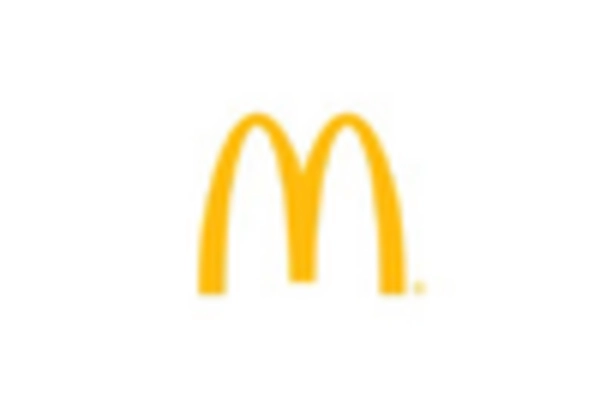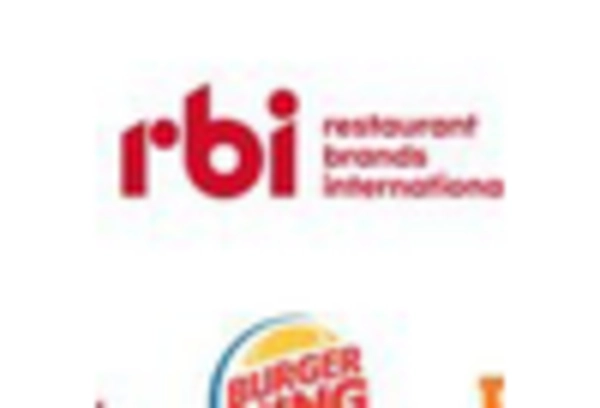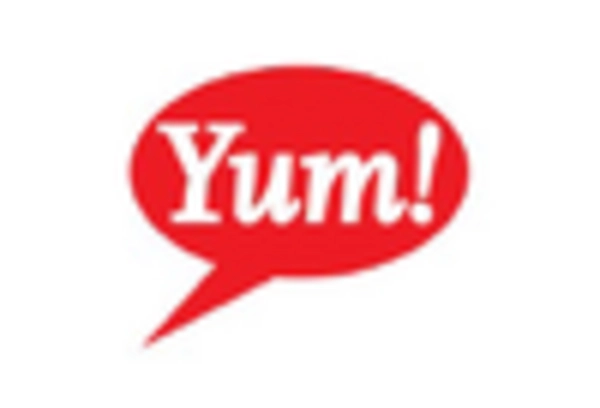The food service market in the US is characterized by a dynamic competitive landscape, driven by evolving consumer preferences, technological advancements, and a growing emphasis on sustainability. Major players such as McDonald's (US), Starbucks (US), and Chipotle Mexican Grill (US) are at the forefront, each adopting distinct strategies to enhance their market positioning. McDonald's (US) continues to innovate its menu offerings while investing in digital ordering systems, aiming to streamline customer experiences. Starbucks (US) focuses on expanding its footprint through strategic partnerships and enhancing its product range, particularly in the premium coffee segment. Meanwhile, Chipotle Mexican Grill (US) emphasizes sustainability and transparency in sourcing, which resonates with the increasingly health-conscious consumer base. Collectively, these strategies contribute to a competitive environment that is both fragmented and concentrated, with key players vying for market share through differentiation and operational excellence.
Key business tactics within the food service market include localizing supply chains and optimizing operational efficiencies. The market structure appears moderately fragmented, with a mix of large chains and independent establishments. The influence of major players is substantial, as they set trends that smaller entities often follow. For instance, the push towards digital transformation and sustainability initiatives is increasingly becoming a standard expectation across the industry, compelling all players to adapt or risk obsolescence.
In October 2025, McDonald's (US) announced a partnership with a leading tech firm to enhance its mobile app capabilities, aiming to improve customer engagement and streamline order fulfillment. This strategic move is likely to bolster McDonald's (US) competitive edge by providing a more personalized customer experience, which is essential in retaining loyalty in a saturated market. The integration of advanced analytics into their app could also facilitate better inventory management and operational efficiency.
In September 2025, Starbucks (US) unveiled a new line of plant-based beverages, reflecting its commitment to sustainability and catering to the growing demand for vegan options. This initiative not only aligns with consumer trends but also positions Starbucks (US) as a leader in the premium beverage segment. The introduction of these products may attract a broader customer base, enhancing brand loyalty and driving sales growth in a competitive landscape.
In August 2025, Chipotle Mexican Grill (US) launched a new initiative aimed at reducing food waste by partnering with local farms to repurpose unsold ingredients. This move underscores Chipotle's (US) dedication to sustainability and could enhance its brand image among environmentally conscious consumers. By addressing food waste, Chipotle (US) not only contributes positively to the environment but also potentially reduces costs associated with waste disposal, thereby improving overall profitability.
As of November 2025, the competitive trends within the food service market are increasingly defined by digitalization, sustainability, and the integration of artificial intelligence. Strategic alliances are becoming more prevalent, as companies recognize the value of collaboration in enhancing operational capabilities and market reach. Looking ahead, competitive differentiation is likely to evolve from traditional price-based strategies to a focus on innovation, technology integration, and supply chain reliability. This shift suggests that companies that prioritize these areas will be better positioned to thrive in an ever-changing market landscape.

















Leave a Comment